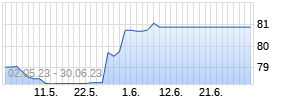
Nach einer gewissen Erholung zu Beginn des Jahres 2023 bleiben die wirtschaftlichen Aussichten unsicher.
03.08.2023 - After some resilience in early 2023, the economic outlook remains particularly uncertain amid further deterioration in business confidence. Yet, investors continue to foresee a soft landing as several central banks continued tightening monetary policy, but also hinted at a possible pause in order to assess the effect of rate hikes.
Murky economic outlook
Earlier this year, global economic activity has been marked by unusually large sectoral divergence with a weak manufacturing sector, yet resilient activity in the services sector. The latest indicators suggest that the latter is weakening, whilst the goods sector is still facing headwinds. If this trend were to persist, expectation for resilient global growth in the remainder of 2023 could be frustrated.
In China, business confidence suggests economic momentum remained weak at the start of H2-2023 after a disappointing second quarter. The non-manufacturing PMI(1) unexpectedly slowed to 51.5 from 53.2 in June, a level last seen in late 2008 with the exception of the pandemic episode. The manufacturing PMI rose to 49.3 from 49 in June as activity shrank for a fourth month, although the size of the contraction narrowed. The composite employment subindex fell again in July and remained below 50 (48.1), suggesting the record-high youth unemployment rate is likely to remain a challenge for the Government. The authorities have made several pledges in recent weeks to revive the economy and boost business confidence, buoying financial markets. Yet, the effectiveness of these measures to boost economic activity is uncertain. For instance, the reduction in banks’ reserve requirement ratio last March, and interest rates cuts announced in June, have so far failed to boost credit growth and the economy.
Pausing for different reasons
Lately, many central banks have hiked interest rates, but also opted to drop forward guidance(2) and adopt a data dependant approach. While the case for an ECB pause is linked to growth concerns, a Federal pause in September seems to be based on inflation optimism.
In the Eurozone, Germany and Italy have disappointed in Q2- 23. After falling in the previous two quarters, Germany’s GDP stagnated in the face of tighter financing conditions and weaker global demand. After a strong start in early 2023, Italy’s economy unexpectedly fell -0.3 per cent q/q(3).
While some of the weakness is in part explained by spending having been brought forward to the first three months of the year, the contraction provides further evidence that the ECB’s monetary tightening is biting. In contrast, France’s economy grew significantly faster than expected ( 0.5 per cent(3)). However, the surprise is in large part explained by a one-off positive contribution from trade, in particular exports of transport equipment, with a notable delivery of a cruise ship. In fact, domestic demand remained very weak amid falling consumer spending.
Looking ahead, investors’ expectations of a rebound in Eurozone economic activity in the coming months are facing the reality of falling confidence indices. What’s more, the latest ECB Bank lending survey showed that credit standards to corporates tightened further, while a record percentage of financial institutions reported declining demand for loans from businesses.
Correspondingly, risks to the economic outlook are increasingly skewed to the downside, which seems to have convinced ECB’s Governing Council to avoid committing to a hike at the September meeting. That said, core inflation was unchanged at 5.5 per cent in July, with services inflation reaching a record high of 5.6 per cent(3), posing risks to inflation expectations and wage setting. The ECB is thus facing a complex dilemma and might be compelled to keep a hawkish(4) tone.
Meanwhile, US GDP economic activity remained moderate in Q2-23, GDP expanding 0.6 per cent q/q (or 2.4 per cent annualised(5)). Consumer spending was somewhat robust thanks to services, but the resilience is facing uncertainty. On the one hand, low savings rate and the limits of using revolving credit to finance current consumption represent significant headwinds, especially since higher interest rates are increasingly hitting borrowers. What’s more, tens of millions of households are bracing for the resumption of student loan payments this autumn for the first time since the pandemic reprieve began more than three and a half years ago. On the other hand, inflation is expected to continue its downtrend, improving households’ purchasing power amid a still strong labour market.
On the inflation front, the June CPI(6) and PCE(7) reports were welcomed, although one should note that one month does not make a trend and core measures remain sticky. Different measures of workers compensation have shown that growth eased very gradually from record-high levels. The number of job openings fell from its peak but stays well above the number of people looking for work. In fact, increased retirements and pandemic health concerns have left a substantial gap in the workforce that could linger if demand for workers remains high. In addition, the growth of the labour force has also been limited by a slower flow of immigration, whilst many potential workers still face persistent barriers to finding jobs that match their needs and expectations.
Looking ahead, the Fed will be assessing the need for further tightening that may be appropriate and, in that regard, the imbalance in the labour market remains paramount in the conduct of monetary policy; due mainly to the role that labour costs play in pushing up consumer prices. The slowdown in wages is a positive sign for the Fed which is trying to bring the labour market into better balance, although it stays incompatible with a swift return of inflation to target. In fact, it remains to be seen whether inflation can drift all the way to 2 per cent without a substantial weakening in the labour market. In any case, investors’ conviction in the ability of central banks to orchestrate a soft landing has grown stronger in the past few months and therefore, the margin for error is very limited for financial markets to remain euphoric.
Finden Sie hier den Artikel (in englischer Sprache) mit Grafiken.
(1) Above 50, this index indicates an expansion in activity, below 50, a contraction.
(2) Indications provided by a central bank on the future direction of its monetary policy.
(3) Source: Eurostat, August 2023.
(4) Position in favour of a restrictive monetary policy to combat inflation.
(5) Sources: U.S. Bureau of Economic Analysis, August 2023.
(6) Consumer price index.
(7) Personal Consumption Expenditure.








